#Soyuz 7K-TM
Explore tagged Tumblr posts
Text
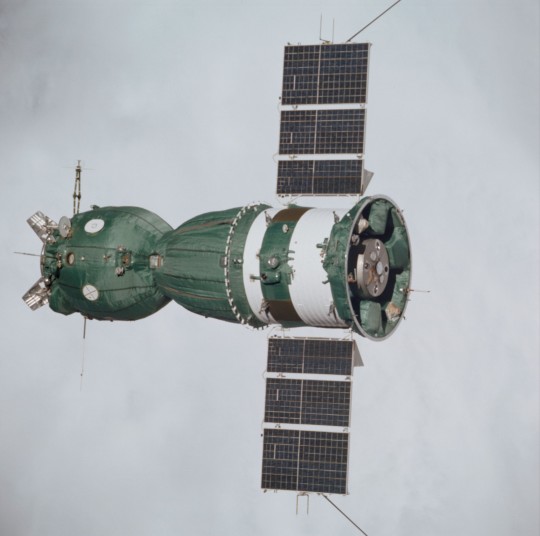
"A view of the Soyuz 19 spacecraft as seen from the Apollo CSM flying the Apollo Soyuz Test Project.'
Date: July 19, 1975
NASA ID: AST-1-056
#Soyuz 19#Soyuz 7K-TM#No.75#Soyuz-U#Rocket#Soviet Space Program#Apollo–Soyuz#Apollo Soyuz Test Project#ASTP#CSM-111#NASA#Apollo Program#Apollo Applications Program#July#1975#my post
194 notes
·
View notes
Text
The only real metric even worth comparing is person-hours and probe-hours, I think, and even then only relative to location, and even then you might want to break it down by instrument/experiment. No point in trying to pit, say, the VeGa 1 balloon against Skylab.
I refuse to give the USSR credit for the first woman in space, though. If you want equality points you have actually keep flying women. Between April 12th, 1961 (first human spaceflight) and December 26th, 1991 (collapse of the USSR) the USSR flew 2* women on 3* person-flights, out of 94*† flying cosmonauts and 142*† person-flights. If we include Interkosmos cosmonauts, these numbers rise to 3 women, on 4 person-flights, out of 101 flying cosmonauts and 150 person-flights.
In that same time, the USA flew 13‡ on 19‡ person-flights, out of 154‡§ flying astronauts and 285‡§ person-flights. If we include payload specialists (whose selection is (was?) more complicated than traditional astronauts) these numbers rise to 15 women on 22 person-flights, out of 154 astronauts and 312 person-missions.
* Not including unflown cosmonauts or Interkosmos cosmonauts †Including Soyuz 1, 11, 7K-T No.39, 7K-ST No.16L, and TM-13 ‡ Including Challenger STS-51L; not including unflown astronauts or payload specialists § Including X-15 flights over 50 miles, even X-15 flight 191, Apollo 1 and Gemini 6; not including Gemini 9, ALT 1-16, or unflown astronauts
Now, 13 is obviously not half of 285. Even if we restrict ourselves just to the Space Shuttle program, 13 is still not half of 201. Obviously inequitable. But 6.7% is a hell of a lot bigger than 2.1%. Today the disparity is even wider -- 20 women and 28 men are active members of the NASA astronaut corps, 1 woman and 22 men are active members of the Roscosmos cosmonaut corps. Only four Russian women have flown to space since 1991, three cosmonauts and an actress. (Not actress-turned-cosmonaut, just actress. She went to the International Space Station to film a movie for state-owned TV broadcaster Channel One Russia.) The US has put up another fifty or so. (exact figure depends on how you want to consider private spaceflights, payload specialists, space tourists, etc.) No Russian woman has flown more than once since Yelena Kondakova in 1997, who flew twice. No Russian or Soviet woman has flown more than twice. There are more American women who have flown to space exactly four times, than there are Russian women who have flown ever. No Russian woman has ever commanded the ISS, or, for that matter, any mission. Arguably the Soviets had one, Valentina Tereshkova "commanded" her single-occupant Vostok 6; but given the technical nature of the Vostok capsule, and the fact her flight was shorter than the three flight preceding her, I'm more inclined to say she was a human life sciences payload. The Soviet Union flew the first woman into space because they heard the US might be doing the same (misconstruing the Mercury 13), and they wanted to be first. Then, they didn't fly a single woman for another twenty years. None of the other four candidates would ever fly. Then the Soviet Union did the first female spacewalk, because they heard the U.S. was going to be doing the same, and they wanted to first. No Soviet or Russian woman has conducted a spacewalk since.
It's shameful. Next time you hear when someone say "the first woman in space was Russian", remember that, in a fight for equality, it's not about the first. It's about the second. The third. The fourth. The fifth. The sixth. The seventh. Forever.
It's about the runners-up. There better be a lot of them.
The Soviets kicked our ass in the space race its so dope "Oh you went to the Moon, yeah thats cool I guess, we got pictures of fucking Venus, you ever been to Venus? No the fuck you did not."
31K notes
·
View notes
Photo
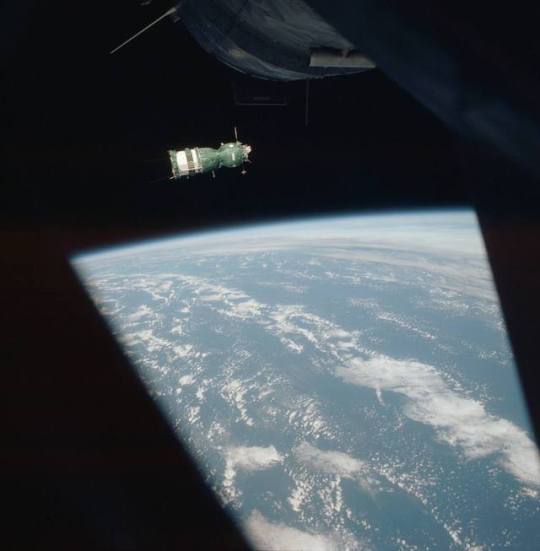
Bir insansız Soyuz 7K-TM uzay aracı Apollo-Soyuz Test Projesi (ASTP) sırasında Apollo modülünden görülüyor.⠀ ⠀ Bu sahne elde tutulan 70 mm’lik bir kamerayla Dünya yörüngesindeki Amerikan Apollo uzay aracının bir buluşma penceresinden fotoğraflanmış. Fotoğraf alttaki Dünya’nın ufkuyla birlikte arka plandaki karanlık gökyüzüne karşı kontrast oluşturan Sovyet Soyuz uzay aracını gösteriyor. Amerikan Kenetlenme Mekanizması (DM) en üstte görülebiliyor. 3 Nisan 1974’te fırlatılan Kosmos 638 ASTP’nin insansız bir denemesiydi. Araç aynı zamanda üzerinde APAS-75 androjen kenetlenme sistemi de taşıyordu. Bunu aynı uzay aracı tipinin bir başka insansız denemesi Kosmos 672 takip etti. Bu görev sırasında yörünge modülünden bırakılan hava (kapsülün atmosfere geri girişi öncesinde atılan) uzay aracında beklenmeyen bazı hareketlere sebep olmuş. Bu da bir sonraki testin de insansız gerçekleştirilmesine yol açmış.⠀ ⠀ #hayallerinotesine #astronomi #uzaydanhaberler #bilim #uzay #teknoloji #tobeyonddreams #astronomy #science #technology #space #tbt
#hayallerinotesine#astronomi#uzaydanhaberler#bilim#uzay#teknoloji#tobeyondreams#astronomy#science#tec
0 notes
Text
Apollo-Soyuz test project.
The Apollo-Soyuz test was a project to connect two spacecraft from rivalling nations, the US and the USSR, using Bill Creasy’s version of the “Androgynous Peripheral Attach System.“
The crew for the Apollo team were:
Thomas P Stafford

Vance D Brand

Donald K Slayton
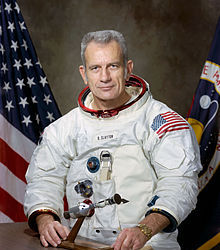
And the crew for the Soyuz team were:
Alexey Leonov

Valeri Kubasov

The crews flew different ships, the US using the Apollo Command/Service Module (CSM) and the USSR used a Soyuz 7K-TM.
CSM

Soyuz 7K-TM
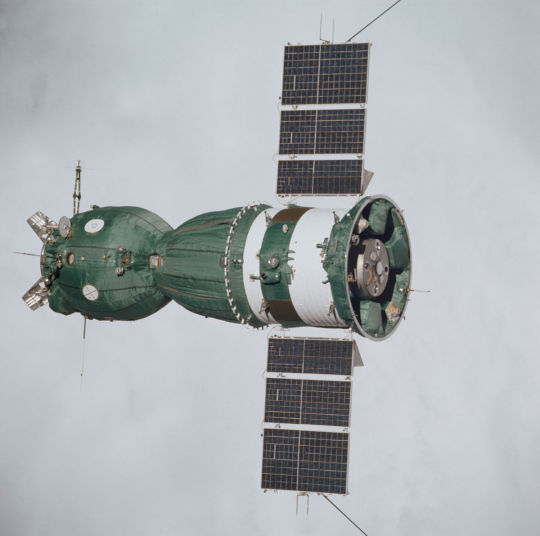
On July 15th, 1975, both ships launched from their countries, and, on July 17th, they both docked with each other.
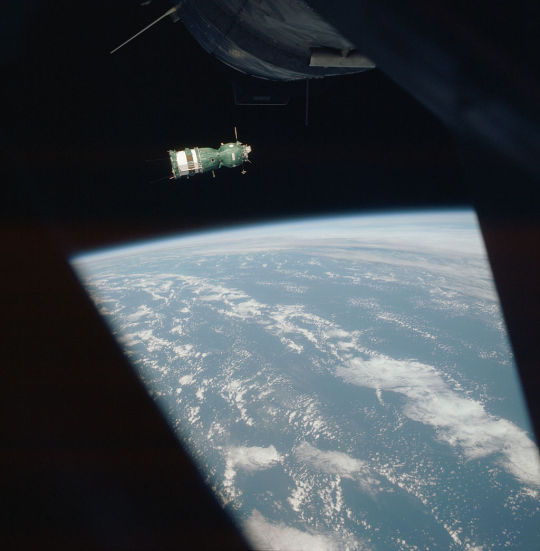


The mission was a success, and after about 2 days, the ships parted and returned, Soyuz landing on the 21st July, and Apollo on the 24th.

https://www.nasa.gov/
0 notes
Text
Case #2: The Apollo–Soyuz Project and other space shenanigans
The Apollo–Soyuz Test Project
Apollo: Block II Apollo CSM and Apollo Docking Module / Soyuz: Soyuz 7K-TM
Thomas P. Stafford, Vance D. Brand, Donald K. Slayton, Alexey Leonov, Valeri Kubasov
Palet Cleanser: Therapy by the band Killjoy
Aftershow: We like the sound of our own voices, Oods accent, Patreon Plug
Stupid link of the episode: https://www.youtube.com/watch?v=BYJB0zyjt70
22 – Oct – 17
New Episode
0 notes
Text
Left to right: Apollo CSM, ASTP Docking Adaptor, Soyuz 7K-TM,

this is what transgender sex looks like
539 notes
·
View notes
Text
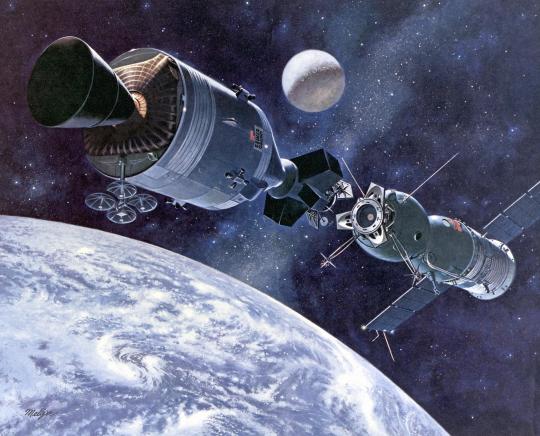
Saturn Apollo Program
"This artist's concept depicts the Apollo-Soyuz Test Project (ASTP), the first international docking of the U.S.'s Apollo spacecraft and the U.S.S.R.'s Soyuz spacecraft in space. The objective of the ASTP mission was to provide the basis for a standardized international system for docking of marned spacecraft. The Soyuz spacecraft, with Cosmonauts Alexei Leonov and Valeri Kubasov aboard, was launched from the Baikonur Cosmodrome near Tyuratam in the Kazakh, Soviet Socialist Republic, at 8:20 a.m. (EDT) on July 15, 1975. The Apollo spacecraft, with Astronauts Thomas Stafford, Vance Brand, and Donald Slayton aboard, was launched from Launch Complex 39B, Kennedy Space Center, Florida, at 3:50 p.m. (EDT) on July 15, 1975. The Primary objectives of the ASTP were achieved. They performed spacecraft rendezvous, docking and undocking, conducted intervehicular crew transfer, and demonstrated the interaction of U.S. and U.S.S.R. control centers and spacecraft crews. The mission marked the last use of a Saturn launch vehicle. The Marshall Space Flight Center was responsible for development and sustaining engineering of the Saturn IB launch vehicle during the mission."
Date: 1974
NASA ID: 9401759
#Apollo–Soyuz#Apollo Soyuz Test Project#ASTP#Apollo CSM Block II#CSM-111#Docking Module#Rocket#Apollo Program#Apollo Application Program#Soyuz 19#Soyuz 7K-TM#No.75#Soyuz-U#Soviet Space Program#artwork#July#1975#my post
153 notes
·
View notes
Text
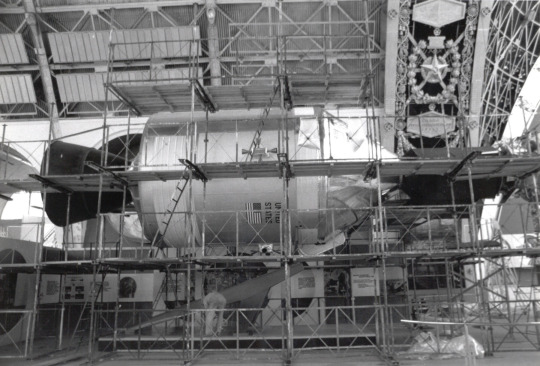
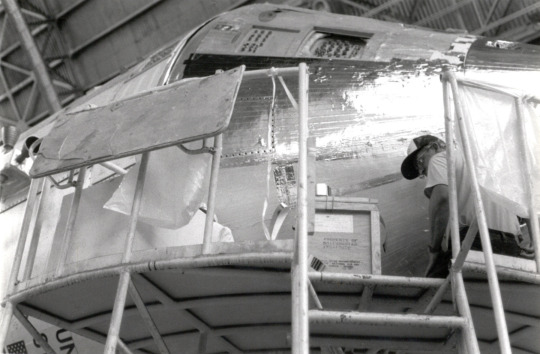
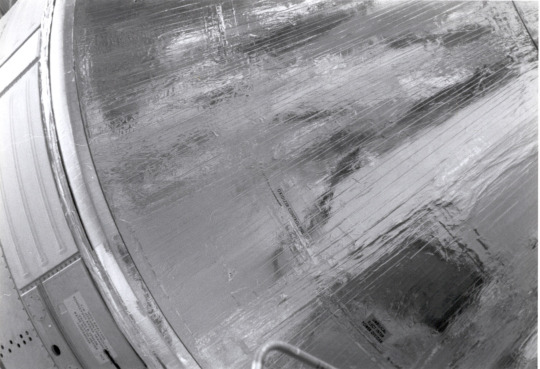
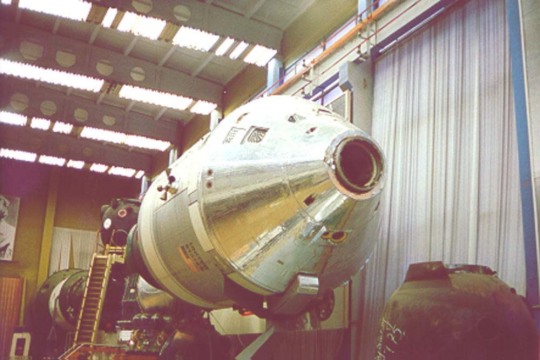
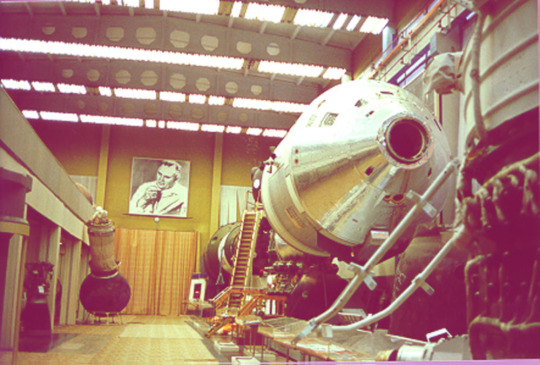
Photos of the Apollo Command and Service Modules (CSM-098) being set up as part of the Apollo Soyuz Test Project display in Moscow. This CSM was used during 2-TV-1 and 2-TV-2, which was the thermal vacuum evaluation testing of the Apollo program. It was donated to the Smithsonian on December 16, 1975.

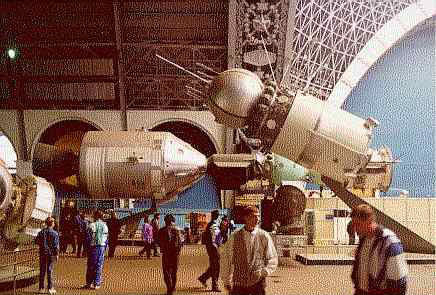
In 1977, it was loaned to the Cosmos Pavillion to be a part of said display. The exhibition was dedicated to Soviet technology from the 1960s, in response to the great New York fair.

It is now displayed at the RKK Energia Museum in Korolyov, Moscow Oblast, Russia, with the Engineering test model of the Soyuz 19. Under the display is the original Soyuz 19 descent module.
Smithsonian Institute Archives: A19772540000
Posted on Flickr by Raymond Cunningham: link
source
Photograph taken by Nallyn: link
#Apollo Program#CSM-098#Apollo CSM Block II#2-TV-1#2-TV-2#NASA#Soviet Space Program#Apollo–Soyuz#Apollo Soyuz Test Project#ASTP#Soyuz 19#Soyuz 7K-TM#No.75#December#my post
67 notes
·
View notes
Text

Saturn Apollo Program
"This illustration depicts a comparison of two space vehicles, the U.S.'s Saturn IB launch vehicle and the U.S.S.R.'s Soyuz launch vehicle, for the Apollo-Soyuz Test Project. The ASTP was the first international docking of the U.S.'s Apollo spacecraft and the U.S.S.R.'s Soyuz spacecraft in space. A joint engineering team from the two countries met to develop a docking system that permitted the two spacecraft to link in space and allowed the two crews to travel from one spacecraft to the other. This system entailed developing a large habitable Docking Module (DM) to be carried on the Apollo spacecraft to facilitate the joining of two dissimilar spacecraft. The Marshall Space Flight Center was responsible for development and sustaining engineering of the Saturn IB launch vehicle during the mission."
Date: June 1974
NASA ID: 0101490
#Apollo–Soyuz#Apollo Soyuz Test Project#ASTP#Apollo CSM Block II#CSM-111#Docking Module#SLA-18#Saturn IB#SA-210#Rocket#Apollo Program#Apollo Application Program#Soyuz 19#Soyuz 7K-TM#No.75#Soyuz-U#Soviet Space Program#June#1974#diagram#infographic#NASA#my post
89 notes
·
View notes
Text
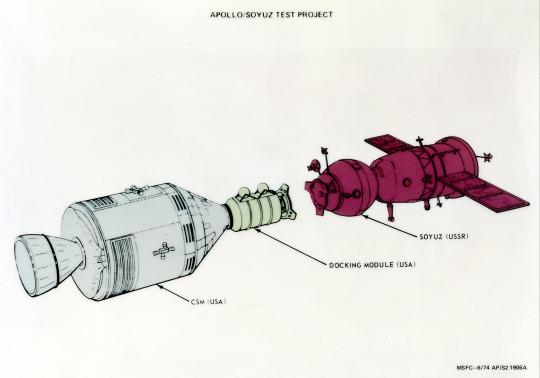
"This illustration shows the docking configuration of the Apollo-Soyuz Test Project (ASTP). The ASTP was the first international docking of the U.S.'s Apollo spacecraft and the U.S.S.R.'s Soyuz spacecraft in space. A joint engineering team from the two countries met to develop a docking system that permitted the two spacecraft to link in space and allowed the two crews to travel from one spacecraft to the other. This system entailed developing a large habitable Docking Module (DM) to be carried on the Apollo spacecraft to facilitate the joining of two dissimilar spacecraft. The Marshall Space Flight Center was responsible for development and sustaining engineering of the Saturn IB launch vehicle during the mission. The ASTP marked the last use of the Saturn Launch Vehicle."
Date: June 1974
NASA ID: 0101491
#Apollo–Soyuz#Apollo Soyuz Test Project#ASTP#CSM-111#NASA#Apollo Program#Apollo Applications Program#Docking Module#Soyuz 19#Soyuz 7K-TM#No.75#Soyuz-U#Rocket#Soviet Space Program#June#1974#infographic#my post#artwork#concept art
74 notes
·
View notes